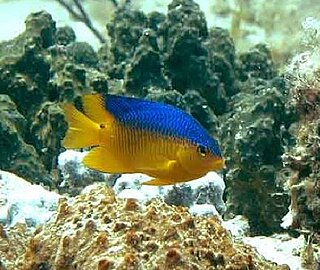
Pomacentridae is a family of ray-finned fish, comprising the damselfishes and clownfishes. This family were formerly placed in the order Perciformes but are now regarded as being incertae sedis in the subseries Ovalentaria in the clade Percomorpha. They are primarily marine, while a few species inhabit freshwater and brackish environments. They are noted for their hardy constitutions and territoriality. Many are brightly colored, so they are popular in aquaria.
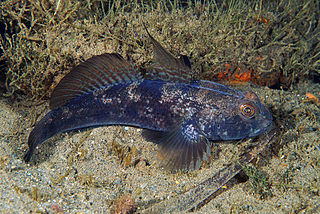
Gobiidae or gobies is a family of bony fish in the order Gobiiformes, one of the largest fish families comprising more than 2,000 species in more than 200 genera. Most of gobiid fish are relatively small, typically less than 10 cm (3.9 in) in length, and the family includes some of the smallest vertebrates in the world, such as Trimmatom nanus and Pandaka pygmaea, Trimmatom nanus are under 1 cm long when fully grown, then Pandaka pygmaea standard length are 9 mm (0.35 in), maximum known standard length are 11 mm (0.43 in). Some large gobies can reach over 30 cm (0.98 ft) in length, but that is exceptional. Generally, they are benthic or bottom-dwellers. Although few are important as food fish for humans, they are of great significance as prey species for other commercially important fish such as cod, haddock, sea bass and flatfish. Several gobiids are also of interest as aquarium fish, such as the dartfish of the genus Ptereleotris. Phylogenetic relationships of gobiids have been studied using molecular data.

The sergeant major or píntano is a species of damselfish. It grows to a maximum length of about 22.9 centimetres.

Haemulidae is a family of fishes in the order Perciformes known commonly as grunts. It is made up of the two subfamilies Haemulinae (grunters) and Plectorhynchinae (sweetlips), which in turn contain about 133 species in 19 genera. These fish are found in tropical fresh, brackish, and salt waters around the world. They are bottom-feeding predators, and named for the ability of Haemulinae to produce sound by grinding their teeth. They also engage in mutualistic relationship with cleaner gobies of genus Elacatinus, allowing them to feed on ectoparasites on their bodies.

The Caribbean reef shark is a species of requiem shark, belonging to the family Carcharhinidae. It is found in the tropical waters of the western Atlantic Ocean from Florida to Brazil, and is the most commonly encountered reef shark in the Caribbean Sea. With a robust, streamlined body typical of the requiem sharks, this species is difficult to tell apart from other large members of its family such as the dusky shark and the silky shark. Distinguishing characteristics include dusky-colored fins without prominent markings, a short free rear tip on the second dorsal fin, and tooth shape and number.
The Brazilian large-eyed stingray, Hypanus marianae, is a species of stingray in the family Dasyatidae. Endemic to northeastern Brazil, adults of this species inhabit shallow coral and sandstone reefs while the young are also found near beaches and in estuaries. This stingray measures up to 40 cm (16 in) across and can be identified by its large eyes, equally long fin folds above and below the tail, and distinctive coloration consisting of various dark brown markings on a yellowish-brown background above, and two pairs of dark brown blotches on a white background below. Reproduction is aplacental viviparous, with females giving birth to one young at a time, twice a year, and using sandbanks as nursery areas. The Brazilian large-eyed stingray is collected by artisanal fisheries and for the ornamental fish trade.

Elacatinus is a genus of small marine gobies, often known collectively as the neon gobies. Although only one species, E. oceanops, is technically the "neon goby", because of their similar appearance, other members of the genus are generally labeled neon gobies, as well. Except for a single East Pacific species, all reside in warmer parts of the West Atlantic, including the Caribbean and Gulf of Mexico. They are known for engaging in symbiosis with other marine creatures by providing them cleaning service that consists of getting rid of ectoparasites on their bodies. In return, Elacatinus species obtain their primary source of food, ectoparasites.

The Gobiiformes are an order of fish that includes the gobies and their relatives. The order, which was previously considered a suborder of Perciformes, is made up of about 2,211 species that are divided between seven families. Phylogenetic relationships of the Gobiiformes have been elucidated using molecular data. Gobiiforms are primarily small species that live in marine water, but roughly 10% of these species inhabit fresh water. This order is composed chiefly of benthic or burrowing species; like many other benthic fishes, most gobiiforms do not have a gas bladder or any other means of controlling their buoyancy in water, so they must spend most of their time on or near the bottom. Gobiiformes means "goby-like".
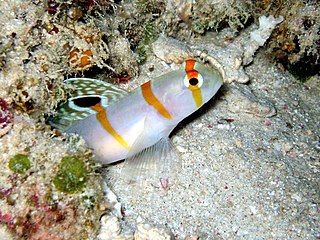
Amblyeleotris randalli, Randall's prawn goby, is a marine benthic species of goby native to tropical reefs of the central Indo-Pacific. This species can also be found in the aquarium trade.

Elacatinus puncticulatus is a species of goby from the eastern central Pacific Ocean, where it is found on reefs from the Gulf of California to Ecuador. This species occurs at depths ranging from 1 to 21m, and usually in association with the sea urchin Eucidaris thouarsii. The size of the goby varies depending on sex, with females being typically smaller than males, and their geographical location as well as their role as a cleaner goby also has impacts on their morphology. Due to their bright coloration and lack of aggression, the species is commonly found in the aquarium trade.

Elacatinus evelynae, commonly known as the sharknose goby, Caribbean cleaner goby, or Caribbean cleaning goby, is a species of goby native to the Western Atlantic Ocean from the Bahamas and the Lesser Antilles to the northern coast of South America, as well as the Antilles and western Caribbean.
Elacatinus chancei, the shortstripe goby, is a species of ray-finned fish in the family Gobiidae. It lives inside or on the surface of a sponge and occurs in tropical waters in the west central Atlantic Ocean, the Bahamas, the Antilles, and Venezuela.

Bryaninops yongei, the wire-coral goby or whip coral goby, is a benthic species of goby widely distributed from the tropical and subtropical waters of the Indian Ocean to the islands in the center of the Pacific Ocean.

Valenciennea helsdingenii is a species of goby from the Indo-Pacific. It is commonly known as the twostripe goby, black-lined sleeper goby, or railway sleeper goby. It can grow up to a length of 25 cm (9.8 in) and is distinguishable by two prominent orange to black lines running longitudinally through its body.

Trimma nasa, commonly called the nasal dwarfgoby or nasal pygmy goby, is a species of goby from the Western Pacific. They are small fish, averaging at around 2 cm (0.79 in) in length. They are bright orange and transparent yellow in life, with a white stripe running down from between the eyes to the upper lip and a dark brown spot at the base of the tail fin. They are usually found in large schools in the sloping or vertical drop-offs at coral reef edges.
Trimma tevegae, commonly known as the bluestripe pygmygoby or blue-striped cave goby among other names, is a species of goby from the western Pacific. They are small fish, averaging at 2 cm (0.79 in), orange-brown with white undersides in life, with characteristic iridescent blue or lavender stripes on the sides and on top of the body. They are usually found in large schools in the sloping or vertical drop-offs at coral reef edges. They are sometimes caught for the aquarium trade, and are also known by hobbyists under the name blue line flagtail goby. The species is named in honor of the schooner Te Vega.

Mycteroperca acutirostris the comb grouper, western comb grouper or wavy-lined grouper, is a species of grouper from the family Serranidae from the warmer waters of the western Atlantic Ocean.
Elacatinus atronasus is a species of ray-finned fish in the family Gobiidae which is endemic to a single reef in Exuma Sound in the Bahamas. It is a species associated with a coral reefs but unlike many other species in the genus Elacatinus it does not engage in cleaning behaviour, feeding instead on particulate zooplankton. It occurs in large, mixed groups in the vicinity of vertical faces which have plentiful holes and near undercut ledges. It forms schools above the sea floor where has been recorded as remaining stationary, hovering above corals by day, resting on the coral during the night. Its reproductive behaviour is unknown. The IUCN assess Elacatinus atronasus as endangered due to its restricted range and the perceived vulnerability of this species to predation by the invasive lionfish, Pterois miles and Pterois volitans.
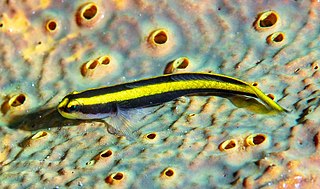
Elacatinus pridisi is a species of goby endemic to the islands of Trindade and Martin Vaz and the seamounts associated to these islands in Brazil. Like other species of the genus Elacatinus, it engages in cleaning behavior. However, unlike other cleaners, it lives in association with both sponges and Montastrea cavernosa instead of only coral. It was also recorded in association with sea urchins.
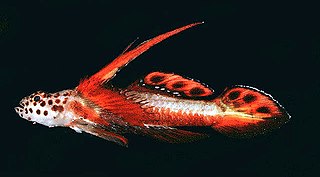
Discordipinna griessingeri is a small, brightly colored, marine neritic fish in the family Gobiidae that is commonly called the spikefin goby or flaming prawn goby. Occasionally it is mislabeled as "Stonogobiops griessingeri" which is a binomial species name that does not formally exist. The spikefin goby has a wide distribution across reefs throughout the western tropical Pacific, Pacific Islands such as Hawai'i or Polynesia, the Indian Ocean, and the Red Sea. It is also occasionally collected and traded as an exotic aquarium fish in multiple countries.















